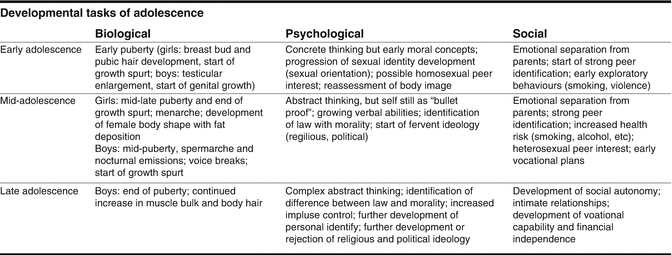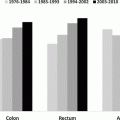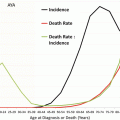Fig. 22.1
Conceptual framework for understandig barriers to adherence (McCue et al. [9] with permission)
It is important to recognize that adherence is dynamic and must be viewed not only in the context of the interaction between patient and medical team but also as a personal cognitive-motivational process [10]. Furthermore, a more nuanced definition acknowledges adherence as a relative rather than an absolute outcome. Adherence, or lack thereof, thus becomes the facilitator of, or barrier to, relevant outcomes rather than an outcome in and of itself.
22.5 Adherence Among AYAs
Challenges associated with adherence transcend the boundaries of disease category and age group; however, there are unique considerations among the AYA population.
22.5.1 Adolescence
Adolescence is commonly defined as the age range between 11 and 19 years. It is a time of significant growth and development [11]. The successful transition from childhood to adulthood demands the achievement of a number of developmental tasks (Fig. 22.2). The accomplishment of these milestones allows the adolescent to individuate from the family and to gain progressively more control and independence. This progression, however, may not only involve tensions but also hinder medical adherence as the adolescent struggles with emerging autonomy. Responsibility for medical decision-making and management shifts from parent to patient, and the tasks of adolescent development may take precedence over other demands such as medication regimens, clinic visits, or lifestyle decisions. Research into chronic diseases such as inflammatory bowel disease, diabetes, HIV, and cystic fibrosis has found that adolescents are a group particularly at risk for poor adherence [14–17].
Recent literature advocates considering adolescence from a biopsychosocial approach, recognizing that adolescence involves all three of these components. Rather than considering adolescence from a discrete, progressive “stage” perspective, it is important to acknowledge that the adolescent exists within a dynamic system. This system is influenced by both internal (physical and psychological) and external (social) demands. Negotiation of any one developmental task of adolescence may influence and also be reliant on the accomplishment of other tasks at the appropriate time [12]. The introduction of a medical condition into the life of an adolescent may perturb this complex developmental system, with implications both for the adolescent’s development and for the medical condition.
In studies of perceived barriers to adherence among adolescents with chronic illnesses, five themes are identified most commonly. These are (1) implications for physical well-being, (2) forgetting due to distraction or lack of planning (e.g., missing doses due to engagement in another activity or not carrying medications when not at home), (3) striving for normality, (4) relationships with peers, and (5) relationships with parents [18]. Additional perceived barriers include treatment perceptions of patients (e.g., lack of belief in treatment effectiveness or usefulness), regime complexity (e.g., number of drugs, number of doses, timing of doses, clarity on medication administration instructions), challenges with organization (e.g., planning when to take medication), and financial costs [18]. Of these themes, the notion of a desire for normality, relationships with peers, and relationships with parents are issues specific to the adolescent population that have not been identified as challenges within the literature on adherence among adults.
22.5.2 Young Adulthood
New expectations and demands emerge as the adolescent transitions to adulthood. The definition of “young adult” varies in the literature; in North America, the term is traditionally applied to those between 18 and 29 years of age. This is a subpopulation which has been acknowledged only recently as distinct from the broader “adult” demographic and which is accordingly less well studied. Use of the term “emerging adult” may be helpful when considering adherence factors among this group. This terminology acknowledges that individuals in early adulthood continue to experience and participate in developmental changes through which an identity, worldview, and enduring approach to problem solving are shaped [19]. Tasks that are encountered during this life stage include adaptation to newly emerging intellectual abilities, balancing of peer and family influences, adjustment to society’s behavioral expectations, transition away from parental involvement, increasing financial responsibilities, internalization of a personal value system, exploration of sexuality, and preparation for the workplace [10, 20]. For those with chronic conditions that persist from adolescence to young adulthood, such as cystic fibrosis and asthma, the time of transition from the pediatric to the adult healthcare system represents a window during which the risk of compromised adherence is particularly high [5, 20, 21].
22.6 Adherence Among AYAs with Cancer
Survival gains among AYAs with cancer lag behind those of children and older adults across shared malignancies [20, 22, 23]. For example, while children with acute lymphoblastic leukemia (ALL) have an approximately 80 % 5-year event-free survival rate, the 5-year event-free survival in AYAs with ALL approaches 60 % [24]. Among the multiple factors that may influence these differential outcomes, adherence is thought to be a significant contributor and remains relatively understudied in this population.
22.6.1 Significance of Adherence
With the advent of more successful treatment for cancers in childhood and adolescence, the role of adherence has gained greater importance because therapy is almost always given with curative rather than palliative intent. The emergence of more oral anticancer drugs similarly demands a greater attention to facilitating adherence as greater responsibility falls on the patient [25]. The clinical implications of poor drug adherence are enormous since strict adherence to chemotherapeutic protocols is essential to secure optimal outcome. Nonadherence with oral chemotherapy may play a role in the long-term prognosis of childhood leukemia [10, 14], in the relapse rate [15–17], and in graft survival after transplantation [12]. In chronic myeloid leukemia (CML), adherence to tyrosine kinase inhibitor (TKI) therapy has been associated directly with molecular response. As TKI therapy is a lifelong intervention in AYAs newly diagnosed with CML, poor adherence may have significant implications for survival [20]. In clinical trials, nonadherence can impact negatively on evaluation of trial aims and goals and may lead to an overestimation of required dosage and resultant significant toxicity and morbidity because of perceived lack of response.
Drug nonadherence may obscure the actual rate of adverse reactions and may lead to a waste of resources. The availability of venous access ports and easy-to-operate pumps makes the administration of parenteral chemotherapy at home (“home care”) possible, but this introduces a new dimension to the issue of nonadherence. Examples of consequences of nonadherence in AYA patients with cancer are captured in Fig. 22.3.
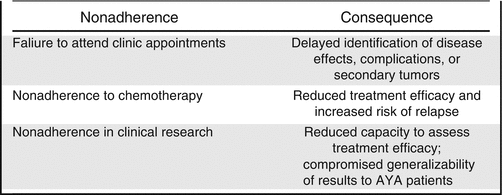

Fig. 22.3
Consequences of nonadherence in AYA patients with cancer. Abbreviation: AYA adolescent and young adult (Butow et al. [10] with permission)
22.6.2 Epidemiology of Adherence in AYAs with Cancer
The rate of nonadherence among AYA patients with cancer is not well known, due to a lack of large-scale, population-specific studies. Furthermore, interpretation of existing studies is complicated by variation in the definition of nonadherence [25]. Among studies in which the AYA group is either the entire sample or a part of the sample, nonadherence rates have ranged from 27 % to 63 % [5, 10, 26]. Adolescents are less adherent than younger or older patients with cancer, even when treated with similar protocols [10]. Adherence in clinical trials is inferior among the adolescent population, affecting the ability to research new interventions that may improve outcomes [22]. When examining rates of treatment refusal, findings vary quite broadly. A study with a large cohort of 576 Australian patients with various cancers, including both solid and hematologic malignancies, found only 1 % of AYAs failed to complete planned therapy due to nonadherence [11]. An older study found that 23 % of adolescent patients refused all or parts of treatment; of this group, 12 % refused all therapy, 35 % refused one treatment modality when multimodal treatment had been recommended, and 24 % started but failed to complete therapy [27].
22.6.3 Facilitators of Adherence
Approaching adherence from a strength-based orientation may prove beneficial since the focus is on promoting success rather than anticipating failure. Strength-based models have a strong evidence base in the adolescent medicine literature [28–30]. Factors that have been found to improve adherence among adolescents with cancer include a positive family relationship with open communication, good patient–provider communication, involvement of the adolescent in treatment decisions and illness management, and supporting continued participation of adolescents in usual activities, including social activities and “rite-of-passage” events such as school formals and graduations [10]. These factors are extrapolated commonly to be relevant to young adults as well.
22.6.4 Barriers to Adherence
Just as there are differences in the biology and characteristics of malignancies in the AYA population, so too do the behaviors and needs of this demographic differ from other age groups confronting cancer. In order to understand the mechanisms leading to lack of adherence among adolescents, clinicians must recognize that adolescent brain development involves early predominance of the limbic system (i.e., the reward system) and only later the maturing of the prefrontal cortex (i.e., executive functioning and planning) to mitigate the impulses of the limbic system. Thus, the adolescent with cancer may prioritize immediate rather than future experiences disproportionately and may be more focused on the present and on surviving the current treatment than on future and long-term outcomes [31]. A review of general barriers to adherence has been addressed in a previous section. Factors that influence adherence specifically among AYAs with cancer are similar to those observed among AYAs with chronic illnesses in general. These include patient emotional functioning (depression and self-esteem), patient health beliefs (perceived illness severity and vulnerability), and family environment (parental support and parent–child concordance) [26]. While these barriers seem to associate more closely with characteristics and behaviors of the individual than the provider or the treatment, adherence challenges may also center around the healthcare system as it often is not oriented toward the unique needs of the AYA group [32]. Of note, while there is a body of literature exploring adherence among adolescents with cancer and among AYAs with other chronic illnesses, the relatively recent acknowledgment of young adults with cancer as a unique population leads to a dearth of significant literature examining the young adult population. Barriers to adherence among adolescents may be assumed to persist for young adults; however, the limitations of this assumption must be acknowledged.
22.6.4.1 AYA Barrier Dimension 1: Treatment Features and Engagement
There is an increased risk of nonadherence with oral rather than parenteral medications, used particularly in treatment protocols for ALL and Hodgkin lymphoma [10, 33, 34]. Among the general population with cancer or other chronic illnesses, adherence has been found to be related to the duration of treatment, the physical characteristics of the drugs such as the number of medications, the number of doses for each administration, and the mode of administration. For nonadherence in general, the cost and the appearance, color, and size of tablets have been found also to influence drug adherence. Interestingly, in studies focusing specifically on adolescents with cancer, these variables have not been identified as significant barriers. In fact, no clear relationship has been found between time since diagnosis, complexity of treatment regimen, or consistency of primary care provider and rates of adherence [5, 26, 35]. Studies indicate that adherence to one component of treatment does not always ensure adherence to other treatment-related demands; however, nonadherence to low-risk treatment demands (e.g., missing an outpatient appointment) has been found to be predictive of nonadherence to high-risk treatment demands (e.g., seeking medical attention when a fever develops) [26].
Adding to the challenge of understanding the impact of treatment characteristics on adherence in AYAs with cancer, there are conflicting findings with respect to treatment side effects. Some studies have found that adherence is better with drugs having less or milder side effects and among patients whose expectations about side effects were worse or about the same as what actually occurred. However, others have found no correlation between side effects and adherence [36].
Treatment in a pediatric rather than a non-pediatric setting has been found to influence outcomes positively among AYA patients with cancer, and improved adherence is one of the proposed mechanisms contributing to these differential outcomes. At present, though, improved adherence among those treated in pediatric settings remains a hypothesis rather than a proven factor in this complex and multifaceted dynamic. Clearly this is an area in which further research is required. What has been shown consistently is that treatment approaches in which the young person has no role in decision-making or management have an adverse effect on adherence [10].
Thus, after synthesizing all of the varying findings on the role of treatment features on adherence, it may be that it is the patient’s engagement in their treatment and relationship with the healthcare system, rather than the nature of the treatment itself, that impacts adherence.
22.6.4.2 AYA Barrier Dimension 2: Patient Emotional and Cognitive Functioning
The emotional functioning of adolescents with cancer is impacted by a strong desire for normalcy. This drive for normalcy may inform the adolescent’s receptiveness and/or adherence to treatment [37].
There are limited studies examining the relationship between psychiatric comorbidities and adherence among AYAs with cancer. The few studies that do exist have indicated that depression and anxiety are both associated negatively with adherence. Depression need not be severe; even subclinical distress has been found to reduce adherence [18, 26]. Studies exploring the role of anxiety in more detail have found that poorer adherence may be manifested by those prone to anxiety in anticipation of potentially threatening situations (“trait anxiety”) rather than those who experience more significant anxiety during an actual threatening situation (“state anxiety”) [38]. Low self-esteem or self-image, while not a psychiatric diagnosis, has also been shown to be associated with decreased adherence [5, 39]. Finally, some adolescents report “forgetting by coincidence” to be a barrier as well [18]. This suggests that executive functioning and organizational skills may impact AYA patients’ capacity to remain adherent to a treatment plan.
22.6.4.3 AYA Barrier Dimension 3: Knowledge, Beliefs, and Attitudes
Inadequate knowledge of the disease and treatment course can present barriers to successful adherence among AYAs with cancer. A lack of comprehension of the potential therapeutic benefits of an intervention may impede adherence further [5]. Beyond simple understanding of facts, how a patient interprets or appreciates the implications of treatment can have significant implications for adherence. Indeed, several studies have suggested that personal subjective beliefs may feature more prominently than factual knowledge in determining adherence [35, 39]. Which beliefs translate into poorer adherence is unclear; both an internal locus of control (i.e., sense that one can control events affecting health) and an external locus of control (i.e., belief that chance or fate has a role in outcomes) may present barriers to adherence [26]. One study found that those who believe that the physician or care team holds complete responsibility for outcomes are less likely to be adherent [39]. Lower perceived illness severity or personal vulnerability may translate into poorer adherence as well [26]. The tendency toward “compensatory beliefs,” defined as “the conviction that negative disease-related behavior may be offset by a different positive behavior” (e.g., “smoking is okay because I eat healthily” or “I take my one medication consistently so missing another won’t matter as much” [40]), is a consideration when examining adherence among AYAs with cancer [5].
22.6.4.4 AYA Barrier Dimension 4: Relationship Dynamics
Lack of parental involvement is consistently reported as a barrier to adherence [5, 10, 18, 26]. Lack of open communication, a controlling parent–child relationship, and family conflict are significant barriers to adherence among AYAs with cancer [5, 10, 41]. Open communication and a collaborative dynamic are similarly important within the patient–provider dynamic. Provider inconsistency, for example, with regard to following a treatment protocol, can erode the AYA patient–provider relationship and affect adherence negatively. Finally, a lack of attention to supporting AYAs in engaging in normative peer activities can undermine adherence, as this demographic places considerable emphasis on peer acceptance and the perception of “normalcy” [37].
22.6.4.5 Other Considerations
To our knowledge, there are no specific studies examining the implications of sociodemographic features for adherence specifically among AYAs with cancer. In studies of the pediatric oncology population and AYAs with other chronic illnesses, low socioeconomic status, linguistic features, ethnicity and race, culture, and immigration status all may impact adherence [5, 33].
22.7 Assessment of Nonadherence
Identification of nonadherence is important in explaining the absence of a therapeutic response, targeting individuals for intensive intervention, and the selection of appropriate adherence-improving strategies. Unfortunately, poor adherence is difficult to anticipate because of the lack of clear predictors. Without the use of tools to complete a formal adherence assessment, only 50 % of providers will identify nonadherence successfully [42].
Both indirect and direct methods have been used to identify and monitor patients’ adherence, with advantages and shortcomings for each technique (Fig. 22.4). Measurement of adherence over a short period of time may not reflect long-term patterns [43], and methods used for research purposes may not be practical for routine clinical use. An individualized approach should be chosen for each patient according to the conditions, personality of the patient, and the healthcare providers. A combination of different techniques, particularly direct and indirect methods, presents the most thorough means of assessment and may allow for the reliability of objective measurements complemented by the insight or context provided by subjective means.
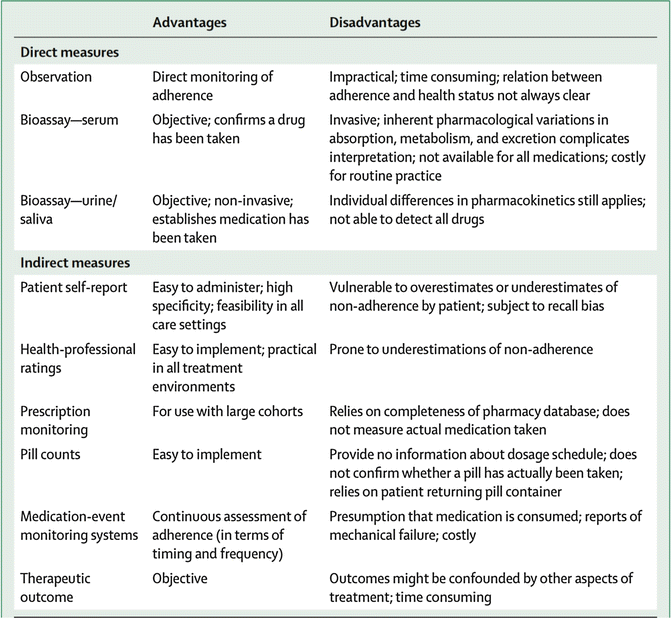

Fig. 22.4




Methods of assessing adherence (Kondryn et al. [26])
Stay updated, free articles. Join our Telegram channel

Full access? Get Clinical Tree



